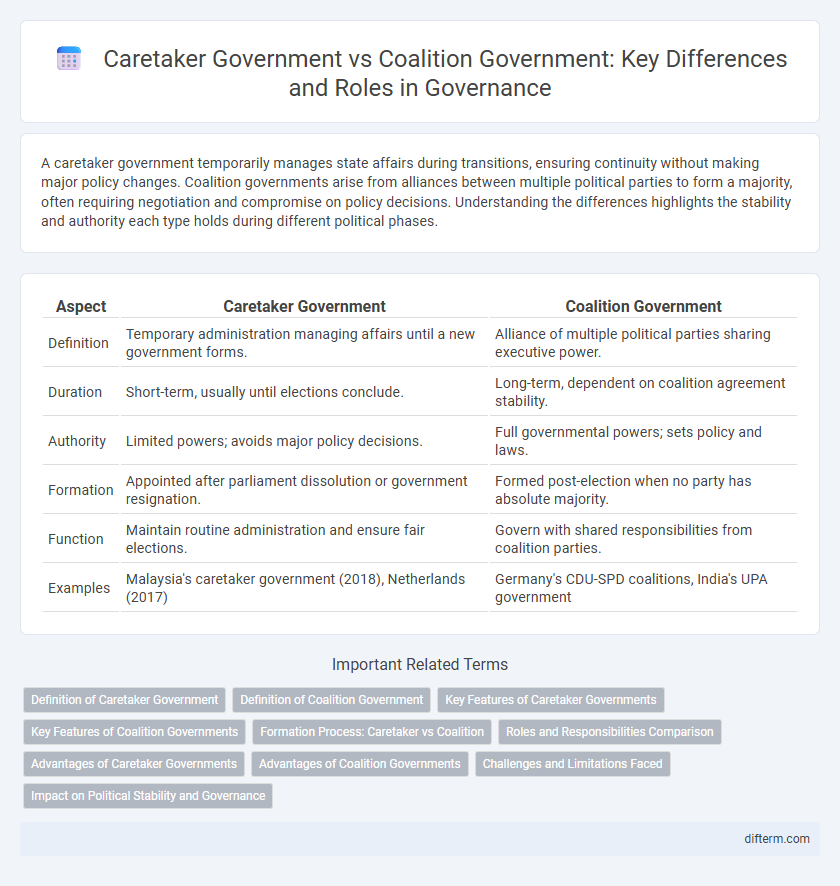A caretaker government temporarily manages state affairs during transitions, ensuring continuity without making major policy changes. Coalition governments arise from alliances between multiple political parties to form a majority, often requiring negotiation and compromise on policy decisions. Understanding the differences highlights the stability and authority each type holds during different political phases.
Table of Comparison
| Aspect | Caretaker Government | Coalition Government |
|---|---|---|
| Definition | Temporary administration managing affairs until a new government forms. | Alliance of multiple political parties sharing executive power. |
| Duration | Short-term, usually until elections conclude. | Long-term, dependent on coalition agreement stability. |
| Authority | Limited powers; avoids major policy decisions. | Full governmental powers; sets policy and laws. |
| Formation | Appointed after parliament dissolution or government resignation. | Formed post-election when no party has absolute majority. |
| Function | Maintain routine administration and ensure fair elections. | Govern with shared responsibilities from coalition parties. |
| Examples | Malaysia's caretaker government (2018), Netherlands (2017) | Germany's CDU-SPD coalitions, India's UPA government |
Definition of Caretaker Government
A caretaker government is a temporary administration that manages the day-to-day operations of a country during the transition period between the dissolution of the previous government and the formation of a new one. Unlike coalition governments, which are formed by multiple political parties sharing power after elections, caretaker governments typically avoid making major policy decisions or long-term commitments. Their primary role is to ensure continuity and stability while elections or government negotiations are underway.
Definition of Coalition Government
A coalition government is formed when multiple political parties collaborate to achieve a parliamentary majority and jointly govern. It involves shared decision-making and policy agreements among the participating parties to maintain stability and effective administration. This arrangement contrasts with a caretaker government, which is a temporary, non-partisan administration managing day-to-day operations until a new government is elected.
Key Features of Caretaker Governments
Caretaker governments operate with limited powers, primarily ensuring routine administration and maintaining neutrality during election periods. They avoid making long-term policy decisions or appointments, focusing instead on preserving stability until a new government is formed. Their key features include temporary tenure, non-partisan function, and adherence to constitutional or legal frameworks restricting their authority.
Key Features of Coalition Governments
Coalition governments consist of multiple political parties that share power by forming alliances to achieve a majority in the legislature, often leading to negotiated policy agreements and power-sharing arrangements. These governments typically feature joint decision-making processes, proportional representation of parties in cabinet positions, and a need for compromise to maintain stability. Unlike caretaker governments, which are temporary and limited to basic administrative functions, coalition governments actively govern and implement policies over a legislative term.
Formation Process: Caretaker vs Coalition
Caretaker governments are typically formed temporarily during election periods or transitional phases, relying on existing officials to maintain basic functions without implementing new policies. Coalition governments emerge through negotiations among multiple political parties to create a majority alliance, often requiring compromises and agreements on shared policy agendas. The formation of coalition governments involves formal agreements and power-sharing arrangements, contrasting with the caretaker government's limited, interim mandate.
Roles and Responsibilities Comparison
A caretaker government primarily manages routine administrative functions and ensures continuity during election periods without making major policy decisions, maintaining neutrality and stability. In contrast, a coalition government involves multiple political parties sharing executive powers, collaborating on policy formulation, legislative agendas, and governance responsibilities. While caretaker governments limit their role to maintaining order, coalition governments actively drive decision-making and policy implementation in alignment with the interests of the involved parties.
Advantages of Caretaker Governments
Caretaker governments ensure political neutrality during election periods, maintaining stability and public trust without implementing major policy changes. They prevent the misuse of state resources by limiting decision-making powers, which safeguards the transparency and fairness of the electoral process. This temporary setup allows for a smooth transition of power while upholding democratic principles.
Advantages of Coalition Governments
Coalition governments promote political stability by fostering collaboration among multiple parties, which often leads to more balanced and inclusive policy decisions. They encourage representation of diverse societal interests, enhancing democratic legitimacy and preventing domination by a single party. Shared responsibility within coalition governments can improve accountability and reduce the risks of authoritarian rule.
Challenges and Limitations Faced
Caretaker governments face significant challenges such as limited authority to implement new policies and constrained decision-making powers, which hinder effective governance during transitional periods. Coalition governments often struggle with internal conflicts and compromised policy agendas due to divergent interests among member parties, leading to political instability and delayed legislative processes. Both systems experience limitations in maintaining consistent governance, but coalition governments face more complex negotiations and power-sharing dilemmas.
Impact on Political Stability and Governance
Caretaker governments typically provide limited political stability as they operate with constrained powers, focusing on administrative continuity rather than long-term policy implementation. Coalition governments often enhance political stability by representing diverse interests and facilitating broader consensus, but they may face challenges in decision-making due to conflicting party agendas. The governance impact differs, with caretaker administrations maintaining status quo operations while coalition governments actively shape policy, influencing legislative effectiveness and government responsiveness.
caretaker government vs coalition government Infographic

 difterm.com
difterm.com